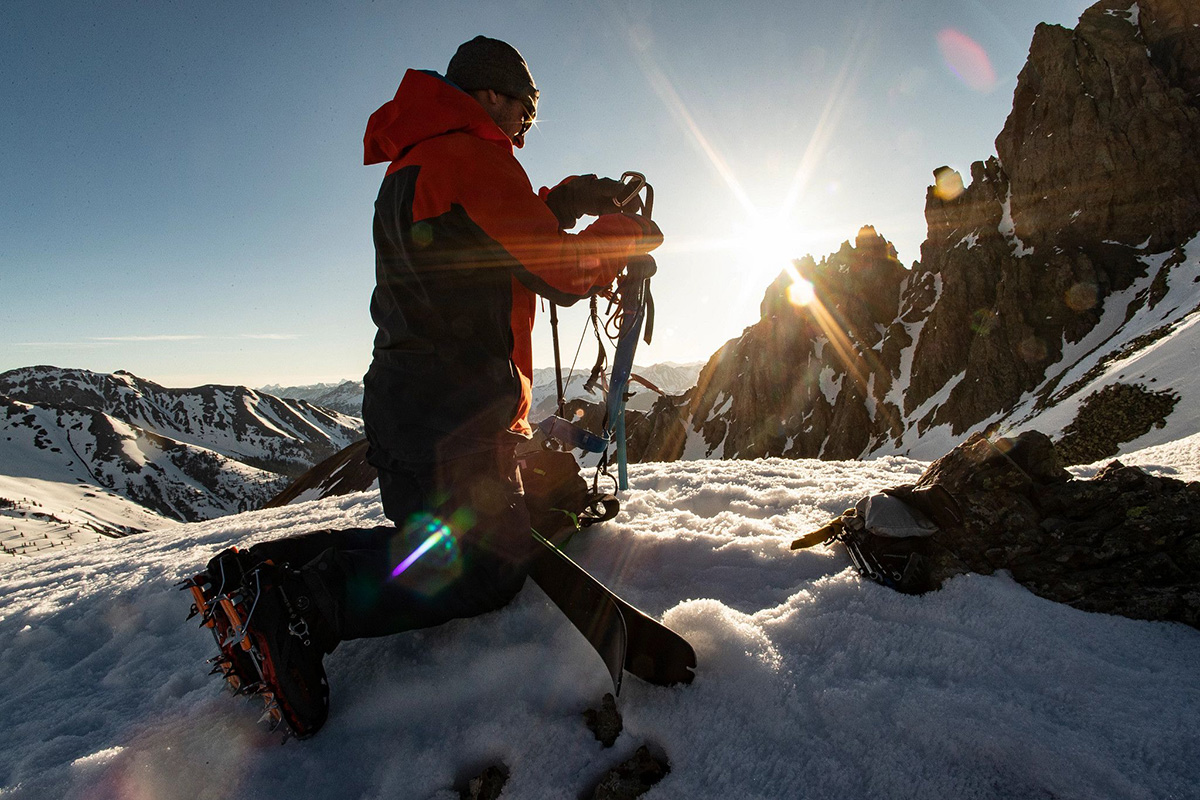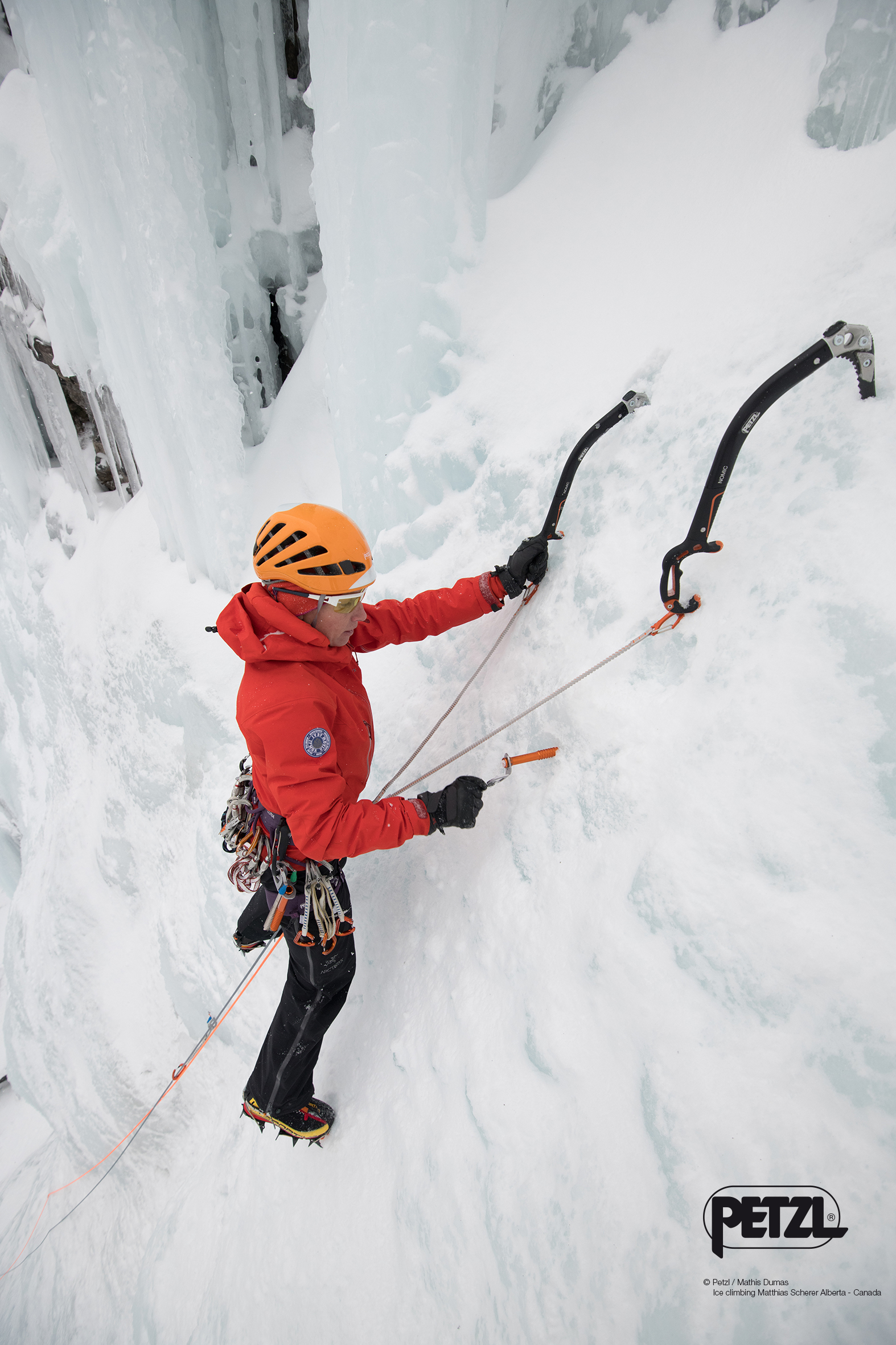You need crampons for glaciers, for climbing on snowy or icy rock, for pure ice climbing and also on some ski tours. Then there are spikes and grödel, which are suitable for lighter snowy trails or for trail running. But how do you find the right crampons? And what are the differences between them?
SPIKES AND Grödel: FOR WINTER HIKING AND TRAIL RUNNING
Spikes are like snow chains for shoes: they are simply pulled over the shoes and come in different sizes. Spikes give you grip on icy ground and compacted snow. They are practical for winter hiking, sledding, trail running or Nordic walking on snow, as well as in work use (snow removal, ski slope service, forestry work, hunting …).
Grödel are more stable than spikes and are sometimes called “half crampons.” Grödel fit only on shoes with sturdy soles and have four to six pronounced prongs, but no front prongs. They are super suitable for relatively flat icy forest trails, snowfields, firn, and harsh snow. You can use grödel for activities such as easy winter mountain tours, trail running or Nordic walking.
LIGHT CRAMPONS AND CRAMPONS
For alpine tours and higher demands, proper crampons are absolutely necessary. Here neither spikes nor grödel are enough, because they do not provide the needed grip.
Light crampons are made of aluminum and impress with their light weight. They are less rigid, thus offer more comfort and have greater flexibility in the binding. The aluminum models give a good grip, but can certainly bend more easily and become blunt much faster. Lightweight crampons are practical for lighter mountain tours, for example, when you don’t want to constantly unbuckle your crampons when changing from snow to rock, or on ski tours when you don’t want to carry so much extra weight.
Regular crampons are made of steel, they are the reliable all-rounder standard solution. They offer you a lot of grip, and their weight is significantly higher than that of lightweight crampons. However, they are also more resilient and durable.
Some manufacturers also offer hybrid crampons. Here, the front part is made of steel and the rear part is made of aluminum. They bring a significant weight savings without sacrificing the outstanding performance.
To be able to use crampons, you need the right footwear. For this purpose, there are conditionally crampon-compatible shoes, but the best are fully crampon-compatible mountain and ski boots.

How many prongs do crampons need?
Crampons come with ten to 14 prongs, including front prongs. How many prongs you choose depends on your adventures. The steeper and more alpine the terrain, the more prongs your crampons should have. For simple high altitude and ski touring, ten prongs are enough. For steep ice, extreme alpine touring and extremely challenging terrain, 14 prongs are recommended. Then front prongs are also absolutely necessary.
What are anti-balling plates?
When walking in snowy terrain, lumps of snow and ice – cleats – can get stuck between the shoes and the crampons. This is dangerous because the crampons then provide less grip and you slip more easily. That’s why it’s important that your crampons have anti-balling plates. These are plastic plates that attach to the bottom of the crampons and prevent “clogging”. Most of the time, anti-balling plates are attached as standard, if not you can order them separately. Important for your purchase decision is whether you can easily replace the anti-balling plates if they ever break.
Crampons with straps, baskets, rocker arm, wire bracket?
Crampons come in different styles for attaching to your shoes. Crampons with a plastic basket at the back and front and a connecting strap for tightening – therefore also called strap binding – fit on pretty much any mountain boot.
But: It is important that your mountain boots have a stiff sole and are not too soft. We therefore recommend you to use at least conditionally crampon resistant shoes (also called category BC and C). Crampons witha rocker arm in the back and a basket in the front (also called semi-automatic crampons) will then also fit and they will give you better grip. This combination binding also fits ski boots without a nose in front.
Automatic crampons fit crampon proof boots (category D) and touring ski boots with nose. They have a rocker arm at the back and a wire bracket at the front and thus develop a clamping effect. Depending on the number of prongs, automatic crampons are then suitable for very demanding high-altitude tours or ice climbing.
There are also crampons that allow you to vary the attachment: They come with a rocker arm at the back, a basket at the front and additionally a wire bracket for the front. This means you can choose to use them as semi-automatic crampons or fully automatic crampons, and you can change the front attachment. So you can always adapt your crampons to your needs and your tours.

OVERVIEW: WHICH CRAMPONs FOR WHAT?
When choosing crampons, it’s important to consider the terrain you’ll be on and how often/long you plan to use them. Your product choice should be dependent on your activities.
Light mountaineering and ski touring
On easy alpine tours you will rather walk over not too steep glaciers and only have rock contact from time to time. Therefore, you can go for light material here – light crampons made of aluminum with ten to twelve prongs are perfectly adequate. For easy alpine tours, crampons with two baskets are sufficient, but semi-automatic crampons always provide a more stable hold.
For ski touring, lightweight crampons are also a good choice if you want to carry less weight. Depending on whether your ski boot has a nose in the front or not, you can choose semi-automatic crampons with baskets in the front or automatic ones with wire brackets in the front.
Demanding high altitude tour
You are rather demanding on the way, go over steeper glacier passages or firn fields and perhaps climb over icy or snowy rocks? Then you need firmer crampons that will hold up. The best choice in this case is a steel crampon with twelve prongs. They have a firm fit and you will have a good performance on the mountain with them. We recommend you to use semi-automatic crampons that have a rocker arm at the back.
Extreme mountaineering and ice climbing
For steep ice and extremely challenging terrain, you need automatic crampons with a rocker arm in the back and wire bracket in the front. To withstand the extreme conditions, they should be made of steel and have vertically oriented prongs. These prongs are often adjustable in length and angle, also there are crampons with a mono prong in the front or crampons where you can convert the front prongs. The extreme crampon models have 14 prongs that can be adjusted and customized.

TRANSPORT, STORAGE AND CARE
You should consider in advance how important the weight is to you. For transport, it is also interesting how far the center bar of the crampons can be pushed together – the smaller you can pack them. Here there are differences of more than 10 cm.
Where you store and carry the crampons doesn’t really matter. They can be carried outside and inside your backpack. We recommend that you pack the crampons in a crampon bag. Crampons get wet and dirty after use, plus the pointed prongs can be dangerous to your pack, other textiles and people, so better keep them well packed in a bag.
How to properly care for crampons? For the longest possible life, good care is important. This is usually relatively simple. For this, you clean your spikes / grödel / crampons from dirt, then let them dry. Once they are dry, you can store them. Every now and then you can file them again, how often depends on your use.
Our whole range of crampons, grödel, spikes and accessories can be found HERE.














